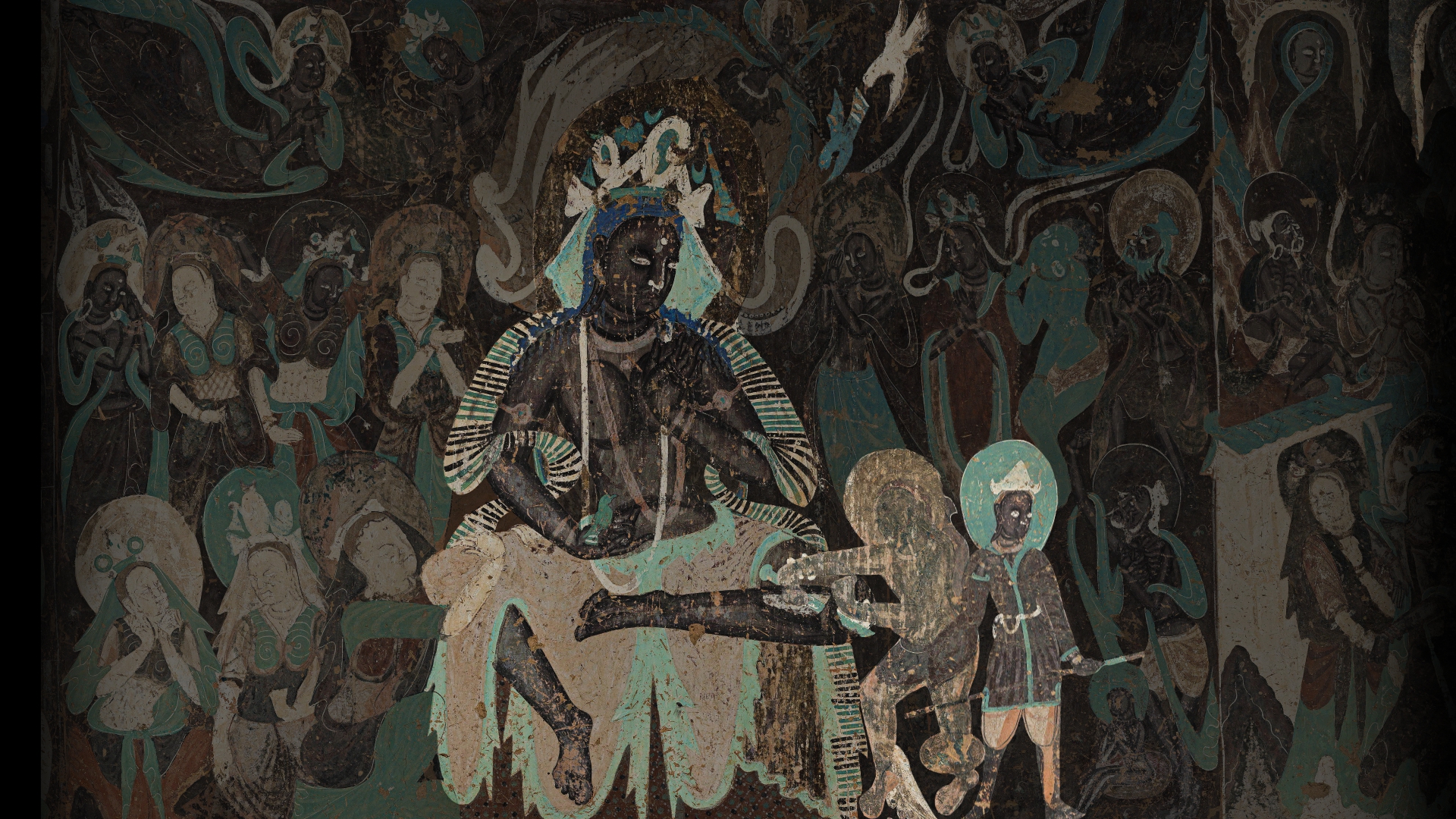A major milestone and world-renowned heritage site within the Silk Road network, Dunhuang preserves more than 400 embellished Buddhist cave shrines in present-day northwest China.
Dunhuang’s cave shrines date from the fifth to fourteenth centuries. Each encloses visitors with murals and carved figures that depict Buddhist legends and paradises. Chronicling innumerable exemplary works of Buddhist artmaking over centuries, Dunhuang forms the largest encyclopedia art collection in situ. More significant than these artistic achievements, the caves offer a glimpse into a universe that rests beyond our known physical reality. Much like the shadowy illusions of Plato’s allegorical cave, the pictorial programs across Dunhuang’s caves reveal higher truths about life, death, and spiritual transcendence.

In Spring 2025, CAMLab contextualizes Dunhuang within Buddhism’s broader currents of space- and art-making that surged across China during the medieval period. Immersing visitors in confluences of light and sound, the Cave Dance and Shadow Cave projects are case studies of Dunhuang caves that reimagine the rich theatricality conjured by depictions of the dramas of the Buddha’s life and dances of transcendent beings. Rebuilding the world’s tallest pagoda in VR, the Embodied Architecture project invokes an 11th century transmission of these dynamics within the towering Shayka pagoda of the Fogang Monastery in present-day Yingxian, China. There, Buddhist pictorial motifs demarcate a journey of ascension toward enlightenment. The Digital Temple project uses an interactive interface to unpack the multiplicity of compositions and multivalent topographies rendered across the murals of Kaihua monastery. By examining Buddhism’s three primary contexts in medieval China—the cave, the pagoda, and the temple—these CAMLab projects reveal the dramatic perceptual experiences and invisible force fields embedded by visual programs within Buddhist sites.

Shadow Cave consists of a series of digital multimedia installations that reinterpret a foundational myth of Buddhism for an international contemporary audience. Around the year 400 CE, a story arose in Nagarahāra (modern-day Afghanistan) that the Buddha had leaped into a cliffside cave and left his “shadow image” there to continue preaching. Radiant like a mirror when seen from afar, it miraculously receded into the rocky surface upon approach. Spread by word and image throughout the Buddhist world, this story inspired pious yearning and ritual visualization, motivating a millennium of icon-making practices and drawing countless pilgrimages along the Silk Road.

Widely acclaimed as Dunhuang’s most representative artistic achievement, scenes of celestial dance performances render beautiful, ethereal figures across numerous Dunhuang caves. CAMLab’s Cave Dance project began by considering Dunhuang’s thousands of dancer depictions as a data set. Taking over 5000 examples of static murals and carved figures, the Cave Dance team used line drawings to establish a common language of postures and train a machine-learning model, which generated animated motion sequences for the dancing figures. To further augment this data, CAMLab collaborated with trained dancers at the Beijing Dance Academy, who performed the movements of dance notation records also preserved at Dunhuang. As a whole, this human-computer collaborative choreography serves as the foundation of the Cave Dance project.
Applying these movement sequences to animate ethereal motifs, the Cave Dance installation is a reconstruction and reimagination of the celestial dance staged within Cave 220 at Dunhuang. From bringing to life a Bodhisattva sculpture (one of the project’s data points) from Harvard Art Museums’ collection, Cave Dance’s performance cycles through medieval texts’ metaphorical accounts of celestial dance. Likening the dancer to a flame in the wind, a fragrance, or a cloud, these texts described celestial dancers as immaterial yet highly sensorial—and as epitomizing the Buddhist transcendent state of the “bodiless body.” The infinite horizon of the Cave Dance’s mirror-lined space further enacts the bodiless body, opening deeper experiential dimensions, even beyond the room’s boundaries. Through this digital performance, Cave Dance elucidates the multifold culture of dance in Buddhist shrines.

The Embodied Architecture project unfolds the cultural logic of the eleventh-century Shakya Pagoda of the Fogang Monastery (located in Yingxian, China). One of the tallest wooden structures in the world, the pagoda rises 67 meters above the ground and was built without a single nail. It epitomizes the sophistication of medieval Chinese carpentry—and also set the stage for a series of ritual practices.

Nestled into the western foothills of the Taihang range in China’s Shanxi province, Kaihua Monastery (c. 1073/1092–96) was once a large complex of structures. However, today only one Northern Song building still stands: its main Buddha hall (the Mahavira hall). With an interior rich in pictorial iconographies, this Buddha hall’s visual program transformed it into a virtual theater by embedding both temporal and spatial transformations within its representations. By unpacking the artistic and religious underpinnings of the temple’s visual program, CAMLab stages a virtual experience of the temple’s transformative process, through which an array of semiotic and sensorial media reconstruct—and facilitate—the transcendence of embodiment.
![]()
![]()











